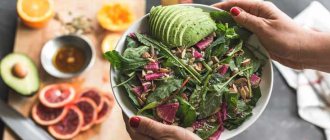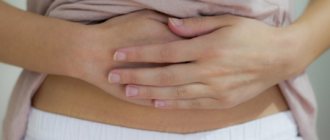When a person’s excess weight is not three to five kilograms, but more than 15–20, they speak of obesity. These are no longer cosmetic problems, we are talking about a chronic disease. With this pathology, fat deposits accumulate in problem areas, gradually affecting all human organs. Diet for obesity is an effective method of combating excess weight in combination with physical activity.
What are the dangers of obesity
Obesity is due to the fact that the amount of food entering the body of a modern person significantly exceeds what is needed for energy production. As a result, the unspent residue is transformed into fat. The quality of the products consumed also matters. If the basis of the diet is made up of easily digestible carbohydrates, they will certainly be deposited in the form of unsightly folds.
Excess weight should not be perceived simply as a visual disadvantage. It is a risk factor for the development of many diseases. The more adipose tissue grows, the stronger its destructive effect on the body.
Attention: patients with excess body weight are three times more likely to suffer from diabetes mellitus, and twice as likely to suffer from pathologies of the liver and cardiovascular system, compared to people with normal weight.
Obesity is a systemic disease; it can affect the functioning of all internal organs.
Among the diseases that are caused by excess weight:
- hypertension;
- Alzheimer's disease;
- strokes;
- arthritis;
- male impotence;
- phlebeurysm;
- angina pectoris;
- pathologies of the respiratory system;
- depression;
- apnea (sudden stoppage of breathing during sleep);
- heart attack;
- gallbladder pathology;
- osteoarthritis;
- diseases of the digestive tract;
- atherosclerosis;
- menstrual irregularities.
It has been scientifically proven that obesity increases the likelihood of developing cancer of the breast, thyroid glands, colon, gallbladder, and kidneys. The most clearly visible connection is between excess weight and malignant neoplasms of the esophagus, as well as the endometrium. On average, body fat reduces a person's life expectancy by 12-15 years.
The situation is aggravated by the fact that obese people have impaired metabolism - this slows down the process of losing weight. But the situation is reversible. It is possible to “lose” even the heaviest weight. To do this, you first need to change your diet. The main mistake many people make is that they try to give up food completely. As a result, periods of fasting are replaced by breakdowns. The weight returns in even greater volumes, and health problems arise. A professional nutritionist should select a diet for an obese person.
Individual cases
In addition to generally accepted postulates and dietary tables, specialists necessarily focus on special, individual cases of obesity. Each of them requires minor but important changes in diet:
- with the visceral type, it is prohibited to include fats and fast carbohydrates in the menu;
- for fatty liver, dietary table No. 5 is prescribed;
- if women are overweight, the consumption of protein foods can be reduced, while men cannot do this in any way: their diet must include lean meat every day;
- if excess weight is accompanied by diabetes, it is possible to use not only table No. 8, but also No. 9;
- in case of obesity in children, a special menu is drawn up, which necessarily contains a lot of plant fiber and carbohydrates (they need energy), a special role is given to delicious desserts with a minimum amount of sugar;
- for heart obesity, table No. 10 is recommended;
- for abdominal pain, the DASH diet is most often prescribed, which wisely combines lean meat, fish, vegetables, fruits and low-fat dairy products in the diet;
- A diet for overweight adolescents during puberty is developed very carefully: it must be balanced and avoid deficiencies of vitamins and microelements.
These points must be taken into account when choosing a power system.
Basic principles of nutrition for obesity
The diet to treat obesity needs to be balanced. The body cannot be left without essential substances, amino acids, and vitamins. An incorrectly selected diet can cause serious endocrine disorders, disturbances in the functioning of the liver, heart and other organs.
The basic nutritional rules for normalizing weight are as follows:
- daily calorie content ranges from 1700 to 2000 kcal. It is calculated individually, taking into account the patient’s gender, age, height, build, and physical activity;
- limiting the consumption of foods containing fast carbohydrates and animal fats;
- filling the diet with fiber, which is low in calories, but fills the stomach for a long time, creating a feeling of fullness;
- The recommended protein intake per day for an adult with average physical activity is 0.75 g per 1 kg of weight;
- split meals make it easier to control the feeling of hunger. It is advisable to eat 5-6 times a day;
- the daily amount of salt should not exceed 5 g;
- exclusion of spices, herbs, smoked foods, pickles, spicy dishes that increase appetite;
- You should drink one and a half liters of water per day. Before each meal, you should slowly drink half a glass of liquid;
- Boil, bake or steam all dishes. Fried foods should be avoided;
- eat at the same time. Additional snacks are prohibited.
Attention: the norm is considered to be a monthly loss of 3 kg of weight due to fat. Faster weight loss is a lot of stress for the body!
A healthy diet for obesity must be combined with dosed physical activity. You need to start with 10 minutes of exercise, gradually increasing its duration and complexity of the exercises.
The listed rules must be observed especially strictly in the first month of treatment. Then the body adapts to the new diet and daily routine. The risk of breakdowns and a return to previous eating habits will decrease.
Cost of diet for excess weight
The cost of products allowed for use in the diet for obesity is low. The exception is seafood products, the price of which significantly increases budget costs. Taking into account the large number of fresh vegetables and fruits required in the cold season, the price of products increases. According to rough estimates, food for a week in winter will amount to 1,800 rubles per week.
You need to understand that mild obesity poses no danger to the body. Compliance with dietary norms in combination with active physical activity guarantees normalization of body weight. To prevent breakdowns, you need to constantly monitor the calorie content of your meals, maintain a drinking regime, and maintain a food balance.
IMPORTANT! Informational article! Before use, you should consult a specialist.
Prohibited and permitted products
Obese patients are usually recommended the so-called dietary table No. 8. It is designed directly to reduce the volume of fat and normalize metabolic processes.
Attention: for patients with concomitant diseases of the cardiovascular system, liver, and digestive organs, individual diets are selected!
Despite the strictness of this diet, it allows you to eat varied and tasty. The list of acceptable products is very extensive. We present the main ones in table form.
| product group | allowed | forbidden |
| flour products | black or whole grain bread (up to 150 g per day) | White bread; baked goods; puff pastry |
| meat | lean beef; rabbit meat; chicken meat without skin and fat; turkey; (any, up to 150 g per day) | pork; goose; duck; mutton; smoked meats; sausages; stew; salo |
| fish | low-fat types (up to 150 g per day); seafood (up to 200 g per day) | all fatty breeds; salted, smoked fish; canned food |
| vegetables | cabbage; cucumbers; radish; zucchini; pumpkin; tomatoes; turnip; greenery; seaweed | potato; carrots (occasionally allowed); green pea |
| side dishes | buckwheat; pearl barley; barley grits; green beans | pasta; rice; semolina; legumes |
| eggs | boiled | fried eggs; fried omelette; |
| fruits and berries | sour fruits and berries; jelly; mousses | grape; bananas; figs; dates |
| beverages | coffee; tea; natural juices from sour fruits and berries; mineral water; rosehip decoction | sweet compotes; jelly; packaged juices; soda |
| seasonings | sauces with herbs in a weak broth; tomato sauce; white sauce with vegetables | mayonnaise; mustard; horseradish; ketchup |
| dairy | kefir; curdled milk; cottage cheese (all low fat) | hard cheeses; sour cream; full fat milk; cream |
It’s good to write out the menu in advance, purchase all the products, and divide them into meals. In this case, you won’t have to “hurriedly” prepare food after work - this can lead to overeating.
Medical indications: in what cases is it prescribed?
This food is prescribed for varying degrees of obesity.
When treating a disease of 1, 2, 3, 4 degrees
Therapeutic nutrition is aimed at combating excess fat in the body.
In the first degree of obesity, sugar and carbohydrates are almost completely excluded from the diet.
It is necessary to reduce the daily calorie intake to 1500. Flour products, fatty meat and fish are also excluded from the menu. Fruits and vegetables are allowed.
In the second degree of obesity, the same foods are excluded from the menu : fatty meat and fish, flour, sweet, smoked. But the number of calories per day should not exceed 1400.
Portions need to be reduced, and forget about overeating. The menu should contain only healthy foods based on vegetables, fruits, berries, low-fat soups, and freshly squeezed juices.
With the third degree of obesity, dietary nutrition should be even more strict. Per day - no more than 1200-1300 calories. Portions should be small.
Pickled vegetables, smoked meats, fatty dishes, sweets are strictly prohibited. It is important to fill your diet with only healthy dishes that contain virtually no carbohydrates.
The fourth degree requires a person to take diet very seriously. This condition is dangerous for the body, so you need to lose weight immediately.
Daily calorie intake is 1000-1100. The portions are very small, overeating is out of the question.
All fatty, sweet, smoked foods are excluded; a person consumes a lot of fruits, berries and vegetables, while eliminating the frying process. Products are consumed boiled or baked.
The diet will be more effective if during its period a person regularly exercises and moves. This promotes active burning of fat cells and weight loss.
Sample menu for the day
Breakfast
- boiled meat (100 g)
- baked beets
- sugar free coffee
Lunch
- vegetable stew
- baked fish (100 g)
- fruit jelly
Dinner
- borscht without meat (150 g)
- low-fat cottage cheese
- dried fruits compote
Afternoon snack
- fresh apples
Dinner
- carrot salad with garlic
- buckwheat
Before going to bed, you should drink one glass of low-fat kefir.
Alternative diets
There are many options for low-carb diets. Not too strict diets include the exclusion of so-called fast carbohydrates. The principle of creating a diet is similar to the “table No. 8” described above. Such restrictions are really useful. They allow the body to receive all the necessary substances and burn stored fat reserves.
Another type of low-carb diet is strict. They exclude almost all products containing these substances. For example, the basis of a protein diet is proteins. They account for up to 80% of the daily diet. Such food quickly saturates, takes a long time to digest, relieving a person of hunger. In addition, the processing of plant and animal proteins requires a lot of energy - this takes up to half of the calories consumed.
Such diets are effective, but must be combined with serious physical activity. Otherwise, proteins that are not needed for muscle mass form nitrogenous compounds that are excreted through the kidneys. The load on the organs increases, creating the preconditions for the development of urolithiasis.
Lack of carbohydrates negatively affects the condition of bones, skin, and hair. From these chemical compounds, the body produces glucose, the main nutrient for the brain. Experiencing a lack of energy, the body begins to use not only subcutaneous fat, but also muscle tissue for its production.
The popular keto diet, which involves a complete abstinence from carbohydrates, is not advisable for beginners. It is allowed to consume only fats, proteins of plant and animal origin. The purpose of such nutrition is to introduce a person into a state of ketosis. This is a type of metabolism in which the body uses ketone bodies (subcutaneous fat derivatives) instead of glucose. The diet is also harmful because, along with carbohydrates, a person stops consuming fiber, vitamins, and microelements contained in the excluded products.
It is possible to lose weight on such a diet, but doing this through complex physiological changes is undesirable. The diet was originally developed for patients with epilepsy, as a link was established between ketosis and a decrease in the frequency of seizures. The keto diet is not recommended for weight loss, but solely as a therapeutic diet.
In any case, before going on this diet, it is better to consult with your doctor. Not everyone can impose restrictions on their diet.
Recommended Products
The basis of your diet for weight loss should be the following foods and dishes:
- Fish. It is best to prepare dishes from low-fat sea fish. In this case, both regular baked fillets and steamed fish cutlets are suitable. Such dishes are rich in valuable protein, so during the diet they must be included in the diet.
- Soups. They should form the basis of dietary nutrition. It is recommended to prepare vegetable and milk soups. You can also add greens and a small amount of legumes to them. No more than twice a week you can cook low-fat soups using chicken broth. It is better to serve soups as a main course for lunch or dinner.
- Meat. It is best to cook dishes from turkey, chicken or rabbit. As for pork and lamb, they are too fatty and are not suitable for dietary nutrition.
- Bread. It is advisable to eat dried black or wheat bread, and eat bread crackers with bran. Fresh buns, donuts and pies are strictly prohibited.
- Vegetable oil. Add to salads in amounts up to 40 g per day. Olive, flaxseed and corn oils will be useful. Butter should be used sparingly.
- Vegetables. Must be present in the diet daily. You need to prepare soups, various casseroles, stews, and juices from vegetables. Peas, tomatoes, lettuce, any greens, carrots, beets, and zucchini will be useful.
- Fruits. You need to give preference to apples, oranges, lemons.
- Milk products. Every day the menu should include low-fat cottage cheese, kefir, sour cream, and homemade unsweetened yogurt.
- Cereals. You need to cook porridge with water without adding salt or sugar. Buckwheat, rice and oatmeal porridge will be useful.
- Seafood (shrimp, mussels, squid). They are rich in valuable microelements (protein, iodine), so they will be very useful in dietary nutrition.
- Honey. This product is unique in its beneficial properties. It is allowed to be used as part of a dietary diet.
Attention! Do not switch to diet food too suddenly. This will not help you achieve weight loss faster, but on the contrary, it can cause a malfunction in the digestive system. It is recommended to introduce the diet menu gradually. You can start by giving up sweets, flour and salty foods.
For whom diets are contraindicated?
For many diseases, as well as during certain periods of human development, strict diets are contraindicated.
First of all, you cannot adhere to a low-calorie and restrictive diet in childhood. The basis of metabolism is laid during intensive growth. Lack of nutrients can cause underdevelopment of the skeleton and internal organs, and cause chronic diseases.
In adolescents, a lack of fats and carbohydrates provokes improper synthesis of sex hormones. In adulthood, this can cause an unstable menstrual cycle and reproductive dysfunction.
During menopause, most women gain weight. This is due to the fact that hormonal imbalance affects all processes in the body, including fat metabolism. Strict diets during menopause are not only harmful, but also useless. You can stop weight fluctuations only by taking estrogen medications recommended by your gynecologist.
Limited nutrition for pregnant and lactating women is strictly prohibited. Lack of nutrients during pregnancy can negatively affect the course of pregnancy. Also, malnutrition often leads to the birth of a weakened child with neurological, immune problems, and developmental delays.
In nursing mothers, weight usually returns to normal on its own within a year, since accumulated reserves are “used up” by the body to produce milk with a reasonable, balanced diet. Dietary restrictions can provoke hormonal imbalance and even greater weight gain.
There are certain diets for patients with certain chronic diseases. Among the pathologies:
- gastritis;
- heart diseases;
- ulcer;
- intestinal diseases;
- disorders of the kidneys;
- pathologies of the liver and gall bladder;
- pancreatitis.
People with diabetes and thyroid dysfunction cannot independently experiment with nutrition. In these cases, weight correction takes place under the strict supervision of the attending physician, who selects a suitable therapeutic diet for the patient.
Causes and Effects
The main reason for rapid weight gain is systemic overeating, in which the body receives calories in excess and does not expend them.
At the same time, doctors note a tendency for middle-aged and elderly people to gain weight. This is due to metabolic disorders and deterioration in the activity of the appetite center in the brain. In this state, people find it difficult to control hunger, causing them to require more food to satisfy physiological needs.
Additional provoking factors for obesity are:
- Sedentary lifestyle. At increased risk are office workers, drivers and other professionals who work while sitting and practically do not move during the day.
- Gourmets and connoisseurs of delicious food. Often, overeating becomes a habit, thanks to which excess weight is gained extremely quickly.
- Hormonal imbalances. Such diseases can lead to rapid weight gain over several months. Getting into shape will be extremely difficult without full-fledged drug therapy.
- Taking certain medications.
- Nervous breakdowns in which a person does not control what and in what quantities he consumes. This is especially common after a long “starvation” diet. In this state, the individual will consume food in huge quantities in order to satisfy hunger and “eat up” problems.
- Hereditary predisposition.
- Pregnancy or menopause.
- Thyroid diseases.
On the subject: How to lose weight after pregnancy
It is important to understand that obesity (especially in advanced stages) is not only an aesthetic defect in appearance. This disorder significantly increases a person’s risk of developing the following diseases:
- oncological lesions of the colon;
- degenerative joint lesions (arthritis, arthrosis);
- scoliosis and other spinal diseases arising from increased load;
- diseases of the heart and blood vessels, including extremely dangerous myocardial infarction, hypertension, coronary artery disease;
- lesions of the digestive system (gastritis, ulcers, pancreatitis, cholecystitis, dyskinesia and many others);
- neuroses, depression, chronic weakness.
Moreover, obesity is often the main cause of complexes and self-doubt. All this makes it difficult to create friendships, start a family, and feel like a healthy person in general.
It is for this reason that it is worth knowing that obesity is a serious problem that needs to be eliminated as a whole. Nutritionists recommend starting with diet and exercise.
How to lose weight without dieting
In most cases, in order to lose weight, it is not necessary to force the body with strict restrictions. It is enough to minimize the consumption of fast foods, processed foods, cream cakes and other unhealthy foods.
Following a few simple rules will help you achieve your ideal figure:
- drink enough clean water. This will not only provide the cells with the necessary amount of moisture, but will also help reduce appetite;
- Exercise will help speed up your metabolism. It is enough to spend 10-15 minutes a day on exercises;
- eat often, in small portions. Do not eat while reading or watching TV. This way you can get distracted and eat much more than you need;
- spend more time in the fresh air, breathe deeper. This way the tissues are saturated with oxygen, metabolic processes proceed faster;
- get a good night's sleep;
- do not finish eating “by force.” It’s good to take short breaks while eating; if you feel full, then you have enough food.
Between lunch and dinner, you can suck on a couple of slices of dark chocolate with a high cocoa butter content (at least 70%). You can replace it with several dried fruits; they must be chewed slowly. Thanks to this, the brain receives a signal that there is sufficient glucose supply, and appetite decreases.
Obesity is not just a harmless cosmetic defect. This is a dangerous pathology that can cause disability and premature death of the patient. It is necessary to normalize weight, but a thoughtless desire for an ideal figure can cause no less harm to a person’s health than fat deposits. You need to lose weight correctly, under the supervision of a qualified nutritionist.
Diets for different degrees of obesity
The therapeutic weight loss regimen depends on the person’s initial weight and the diagnostic results obtained. The diet during the initial phase of obesity and in the case of advanced disease will be different.
All types of diets are characterized by observance of mandatory rules:
- daily consumption of 1.5-2 liters of clean water;
- the basis of the diet is proteins, healthy fats, slow carbohydrates;
- exclusion of high-calorie foods from the menu;
- 5 or 6 meals a day, the volume of one serving is 200-250 g;
- last meal – 2-3 hours before bedtime;
- acceptable methods of heat treatment of food - boiling, stewing, baking;
- presence of moderate physical activity and sports.
Types of diet therapy for obesity:











